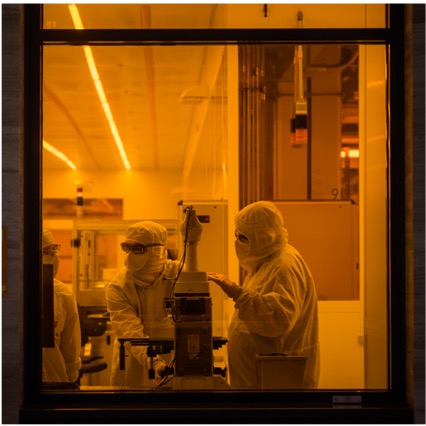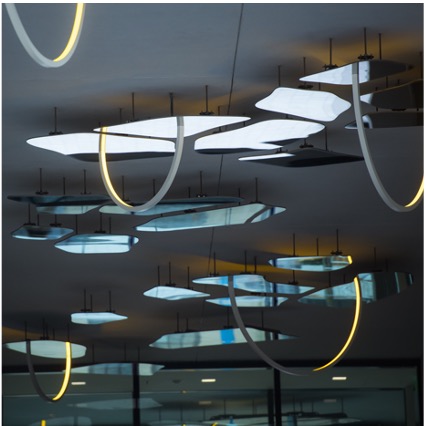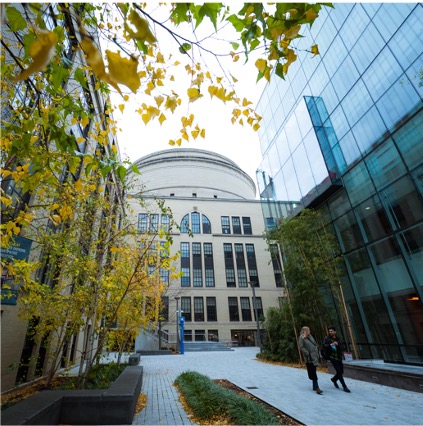Welcome to MIT.nano!
We’re MIT’s open-access, shared facility for nanoscience and engineering, located in the Lisa T. Su Building. MIT.nano does not belong to any specific department or school. Instead, we are part of the Office of the Vice President for Research and advised by a faculty leadership council drawn from multiple departments in science and engineering. This reflects our mission to serve the entire campus—any trained student, faculty, researcher, or external user can access our facility—and results in a broader vision for what tools and capabilities we support. Since our opening in October 2018, we’ve installed over 160 tools and instruments, and trained over 700 users!
As an active research facility, we cannot accommodate every tour request we receive. However, we welcome you to visit our public, exterior spaces. Use this guide to learn more about MIT.nano while you explore MIT’s campus. These points of interest are marked on this map.
MIT.nano Cleanroom
Outside MIT.nano, in the North Corridor between Buildings 12 & 24, you can see into our cleanroom.
 A nanometer is one billionth of a meter. When you are working at the nanoscale, a speck of dust is a wrecking ball. Cleanrooms provide a pristine environment for research at this tiny scale. Looking through the window, you may see some researchers wearing bunny suits. These full body coverings are necessary to minimize the dust and contamination an individual brings with them into the cleanroom.
A nanometer is one billionth of a meter. When you are working at the nanoscale, a speck of dust is a wrecking ball. Cleanrooms provide a pristine environment for research at this tiny scale. Looking through the window, you may see some researchers wearing bunny suits. These full body coverings are necessary to minimize the dust and contamination an individual brings with them into the cleanroom.
MIT.nano’s cleanroom consists of two levels, each two stories high, stacked like a layer cake. The cleanroom working space you see here is “Class 100,” meaning in a cubic foot of air, there are fewer than 100 particles larger than half a micron (500 nanometers). The floor above this space is the fan deck, with equipment to completely clean and replace the air on this floor every 15 seconds. The fan deck is what maintains the Class 100 conditions required for nanoscale research. You will notice that half of this floor is illuminated with amber-colored light to prevent interference with lithography, etching, and other processes and tools that use ultraviolet light.
Just around the corner, near the West Lobby, check out the wafers in our cleanroom window!
Olafur Eliasson’s Northwest Passage
Outside MIT.nano’s West Lobby, in the breezeway between Buildings 12 & 13, look up at the golden hoops.
 All MIT building projects dedicate funding to a permanent art installation. For MIT.nano, the installation is the golden hoops and mirrors under the breezeway. Conceived by globally recognized artist Olafur Eliasson, the work is “Northwest Passage,” a play on the breezeway’s role as a passage under the building and his meditation on the melting of the polar ice caps.
All MIT building projects dedicate funding to a permanent art installation. For MIT.nano, the installation is the golden hoops and mirrors under the breezeway. Conceived by globally recognized artist Olafur Eliasson, the work is “Northwest Passage,” a play on the breezeway’s role as a passage under the building and his meditation on the melting of the polar ice caps.
If the ice melts sufficiently, it will open up the Northwest Passage, a sea channel to the Pacific Ocean from the Atlantic Ocean. Originally from Iceland, Eliasson lives and works in Germany. As someone from the North, he is concerned about the impact of climate change. The exhibit serves as a reminder of how important the research done at MIT and MIT.nano is to finding solutions to the world’s greatest challenges, including climate change.
Improbability Walk
On the south side of MIT.nano, in the courtyard that parallels the interior Infinite Corridor, you can take a selfie with the MIT dome.
 This outdoor walkway, the Improbability Walk, is named in honor of Mildred Dresselhaus (1930-2017), Institute Professor and beloved member of the MIT community. Dresselhaus, known around the world as the “Queen of Carbon Science,” was awarded the Kavli Prize, the Presidential Medal of Freedom, and the National Medal of Science, among many other accolades. She was the first woman to receive rank of full, tenured professor at MIT and the first woman to be named Institute Professor, MIT’s highest faculty honor.
This outdoor walkway, the Improbability Walk, is named in honor of Mildred Dresselhaus (1930-2017), Institute Professor and beloved member of the MIT community. Dresselhaus, known around the world as the “Queen of Carbon Science,” was awarded the Kavli Prize, the Presidential Medal of Freedom, and the National Medal of Science, among many other accolades. She was the first woman to receive rank of full, tenured professor at MIT and the first woman to be named Institute Professor, MIT’s highest faculty honor.
When she was a PhD student at the University of Chicago, Dresselhaus lived in the same neighborhood as the famous scientist, Enrico Fermi. They would walk together to school, and she said that the conversations on these walks is how she learned to be a scientist. At MIT, she would walk and talk with her students and colleagues whenever she could. Dresselhaus said her journey from a humble background as the daughter of poor immigrants to her many accomplishments and honors was “highly improbable.” The Improbability Walk is named in fond remembrance of Millie for these reasons.
